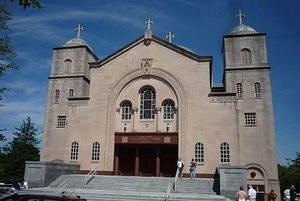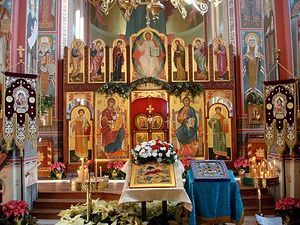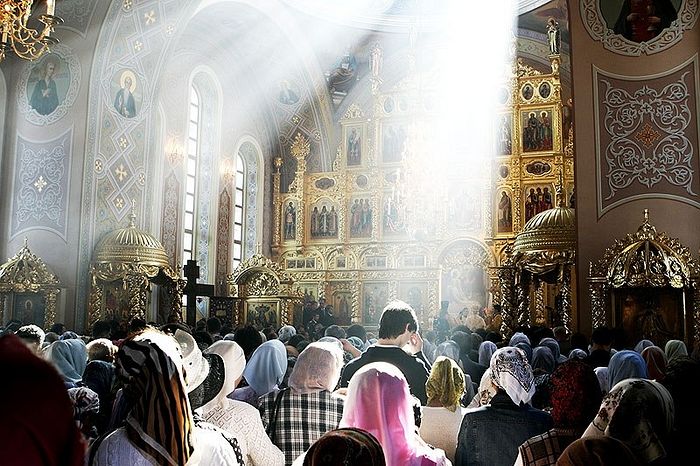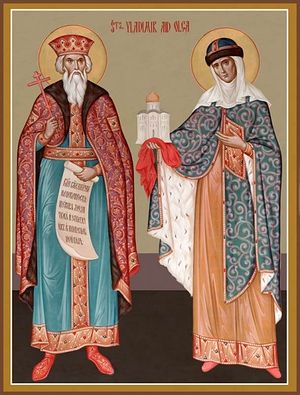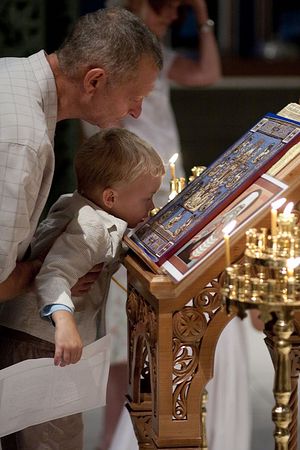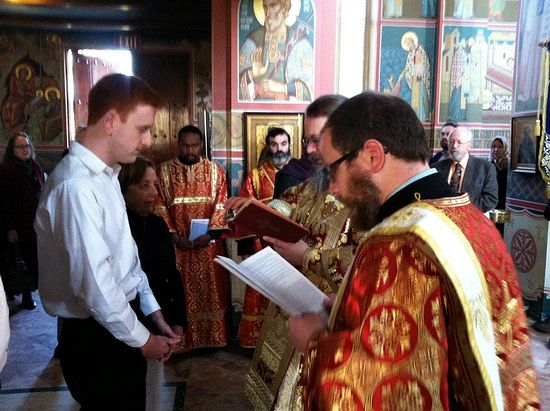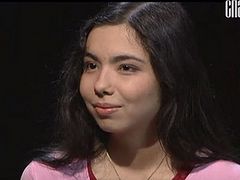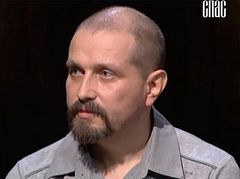As we continue to commemorate the feast of the Lord’s Baptism we are going to begin posting in parts the story and reflections of one of our authors’ conversion to Orthodoxy, Ryan Hunter, a recent graduate in European History from Stony Brook University, New York.
* * *
“In His unbounded love, God became what we are that He might make us what He is.” —St. Irenaeus (d. 202)
I am in love. The object of my affection, or rather, my devotion, is not a person per se, though it is very much alive. It has been alive for 2,000 years, persisting through seemingly insurmountable odds, and in that time it spread from the eastern shores of the Mediterranean north and east, ultimately to the shores of Alaska and the New World. Now it is very much established and thriving here in the US. What is this thing that has become such a defining part of my life?
I have fallen in love with the Orthodox Church.
It is difficult for me to render into words an account of the transformation that this awakening has wrought in all areas of my life. I feel myself to be at last truly satisfied, spiritually and emotionally. I feel enriched beyond description after years of an ever-present void. From the depths of my heart I sense that I am now a more fulfilled Christian, and above all I know that I am a more inspired human being. Sadly in this increasingly secular society, many people my age do not want or desire such inspiration.
For the rare college student who craves a deeper inspiration that goes beyond a routine weekly church hour, for anyone who wants to enter into a new level of spiritual life, I urge him or her to consider Orthodoxy. It has awakened in me a kind of spiritual consciousness that I never imagined I would experience, a kind of spiritual inspiration that very few of my non-Orthodox friends have today.
For this awakening, I am, and will always be, forever grateful.
Introduction:
“Remember constantly that the light of your soul, of your thoughts, and of your heart comes from Jesus Christ.”
St. John of Kronstadt (1829-1908).
Before I begin, I wish to thank two dear friends who have had the biggest impact on introducing me to Orthodoxy, Rebecca Dixon and Gillian Davies. They exemplify all that is best about the faith first and foremost in their incredible kindness and warmth. They are two of the most intelligent, cultured, and open-minded individuals I have ever met. Typical of most Orthodox who encounter a would-be-convert, they would probably tell you that they had little to do with my spiritual journey, saying such a thing is something that can only begin and evolve in the individual’s heart and soul.
But they did more than simply start me off on my journey. After I met them when I started attending weekly 5 pm Orthodox Vespers at Kay Spiritual Center at American University during the fall 2010 semester, they provided me with so much counsel and encouragement. They were welcome and informative company to the Sunday Liturgies I insisted on attending as often as I could. They answered the many questions I had, and introduced me to two beautiful churches. Most of all, they shared with me their own unique personal experiences with Orthodoxy.
Because Gillian, a Greek-British American, preferred to attend Sunday liturgy at St. Sophia (Holy Wisdom), the Greek Orthodox cathedral a mile down Massachusetts Avenue from American University, I was able to experience worship in that church whose beauty is truly breathtaking. Gillian has graduated, so besides one very kind, thoughtful priest there, Fr. Dimitri Lee, who sang the weekly vespers at American, I know no one at that Cathedral. While I decided not to become a member of the St Sophia parish, I will be glad in the future to be a communicant on the occasions when I decide to visit that beautiful church.
I think Gillian understands. She proved invaluable in helping me improve on my Greek-reading, though I think I will continue to pronounce the letter ‘tau’ incorrectly in many instances! In our walks to and from church during Great Lent on Mondays when we trekked over to hear Fr. Dimitri sing the office of Great Compline, she shared her thoughts on the Faith, the Church, and some of her own personal views on its teachings and St. Sophia’s own traditions, as a parishioner and someone who was “cradle” Orthodox. I realized that by entering the Church, I would not be required to subscribe to some sort of ideological litmus test, but be encouraged, in every liturgy, and indeed, in every moment of my life, to believe in the Orthodox way, and put its teachings into practice. Thanks to Gillian I have come to appreciate how the Church stands for certain things, and does take specific positions on contemporary issues, but it does not focus so much on projecting an absolute image of itself to an ever-changing world as much as it emphasizes staying true to its rich Tradition.
As soon as I met Rebecca I saw that she has a love for life and an infectious spontaneity, twin attributes inestimable in any friend. Although she was only in DC during the fall 2010 semester, we’ve kept in touch, especially on Facebook where I love to share my latest stories and updates about my spiritual life at St. Nicholas Cathedral, the church she introduced me to in November. She loves to converse on all manner of things, from travelling abroad (she recently was in India spending her summer in New Delhi and Kashmir) to Canadian politics (she worked in the Library of Parliament in her native Ottawa) to different cuisine and languages.
I will always remember our many treks to St. Nicholas Cathedral for the Sunday Divine Liturgy, both for the amazingly lively conversations we had at 8:30 on mornings when most students slept in, and for the frequent snow and rain that often made it necessary to run to church! When she visited DC during Holy Week in April, perfect timing to have my old Orthodox buddy back in town, we had to sprint through pouring rain to get to the morning liturgy on Holy Wednesday, and I was in a suit! (Neither of us had umbrellas.) I remember that liturgy especially because upon entering St. Nicholas, Rebecca, who sang in her church’s choir back in Canada, immediately walked over to where the choir members stood, and proceeded to join them and the Metropolitan in their singing!
She is a member of the Orthodox Church in America, an autocephalous (fully self-governing) body of several hundred thousand Orthodox in the US, Canada, and several communities in Central America. In addition to its Russian roots, the Church has a large and steadily growing number of members entering from mostly mainline Protestant groups, but there have also been considerable numbers of Catholic converts, as well as some evangelical Christians who have all come to Orthodoxy in recent years through the OCA.
His Beatitude Metropolitan Jonah, primate of the Church from 2008 [to 2012], has said in interviews that,
“Our churches embrace a very broad diversity of peoples across the continent.”
Rebecca’s family exemplifies the incredibly embracing diversity of the OCA; her mother’s family is religiously Jewish, and her mother made the difficult decision to enter the Church after she was born. Rebecca explained how her mother did not want to lose any of the cultural heritage with which she had grown up. After much thought and prayer her mother came to realize that embracing Orthodoxy did not mean she had to give up her family or her Jewish cultural roots. According to Jewish custom, which passes on the faith tradition through matrilineal descent, Rebecca and her mother, in addition to being Orthodox Christians, are also, and will always be, Jewish. As someone who has Jewish roots on my mother’s side of the family, I always thought it was beautiful that Rebecca could be both Jewish by heritage, and a Christian in her religion.
In addition to Rebecca’s wonderful sense of humor, and what I would describe as the enormously helpful “education” that she gave me on really “all things Orthodox”, she also enlightened me early on in my studies of Orthodoxy, as I became increasingly interested in converting, that the OCA was no stranger to controversy. The Church has been going through controversy in many ways as painful as that which has been engulfing the Roman Catholic Church in recent years (albeit of a different cause.) I’m so grateful that she had the strength and forthrightness to share this with me.
More than anything else, I am grateful to Rebecca for introducing me to Saint Nicholas Cathedral, two blocks down Massachusetts Avenue from St. Sophia. This church is the primatial cathedral of the Orthodox Church in America, and it has been my spiritual home ever since that November day when she first took me with her to experience the Divine Liturgy there.
Finding Orthodoxy: The Beauty of the Faith and the Soundness of its Teachings
I will first address an area that is of less importance compared to the other doctrinal reasons behind my conversion, but still very important to me: the incomparable beauty of Orthodox worship.
I have never come across anything quite like the Divine Liturgy, the Eucharistic liturgical service of the Orthodox Church. As St. John of Kronstadt observes in his “Thoughts on the Divine Liturgy”,
“The divine services are a blessed fount from which the heavenly Grace abundantly pours forth its gifts upon all those who serve the Lord in fullness of heart—gifts of mercy, peace, consolation, purification, sanctification, enlightenment, healing, renewal, and—what is most precious—the gift of worship, in Divine Liturgy and Holy Communion.”
This “blessed fount” contains a beauty that is so transportive, so moving to the soul that once I experienced it for the first time, I had a powerful sense that something in me had changed forever.
Before I experienced the Liturgy for the first time, I had no idea such ethereal worship existed in Christianity. For many students who were raised in one of the Western Christian traditions, used to a primarily logical and rational approach to theology and spirituality, Buddhist and Hindu devotional practices can often seem refreshingly mystical, offering a more beautiful, transcendent approach to the divine. I know of many former Protestants and Catholics who have moved away from Christianity to pursue these mystical practices, leaving behind faith in Christ largely because they were bored or disillusioned with the only form of Christianity they knew. They were not generally grappling with issues of Christian soteriology or theology when they left, but simply found themselves drifting, disconnected from any real deep sense of spiritual engagement, challenge or fulfillment as Christians. Unfortunately, they were unaware that Eastern Orthodoxy exists and that for centuries it has offered its faithful a profoundly mystical- yet still a corporate and communal- approach to God.
Within the life of the Church, our path to theosis is not some lonely climb on our own unique “spiritual journeys” as an island unto ourselves, for such an approach to faith leaves anyone ultimately feeling alone and vulnerable. Nor is the Church’s admonition that life in Christ requires a life lived together as His living Body a burdensome, narrow-minded insistence that we obey its “rules”. Rather, the Church insists we partake of and unite with the Body of Christ literally, communally, and liturgically because she recognizes the most basic truth about the human person: man is created in the image of God, and thus finds his highest fulfillment as someone who worships God and rejoices in His presence. The Church holds that the most beautiful and fulfilling way to worship God is in the Divine Liturgy, her principal worship service. Man is thus, at his core, a liturgical creature.
Like any Liturgy, such rejoicing is always magnified when it occurs with many worshipers present adoring God, rather than a few faithful standing by themselves at a sparsely attended weekday service. At these weekday services one gains so much wisdom and becomes even more aware of the fullness of the Church’s liturgical life and her constant witness of the Gospel, but undoubtedly the occasions of greatest rejoicing are when the whole congregation joins together at wedding liturgies, the great Feasts of the Church, chrismations and baptisms, etc. These occasions are always filled with great rejoicing because they are a time of true, organic fellowship and community as the Body of Christ united around the bishop.
The Church recognizes that each human life is of immeasurable value and absolutely unique, and any bishop will tell you that our experiences of God differ from person to person. For instance, if you ask parishioners to name at what point in the Liturgy before communion they feel closest to God, or which liturgical prayers move them the most, you will get many different answers. Some people feel most comfortable praying alone in the quiet of their room; other people like to pray silently as they go about during their day, etc. A way to think of this is that we travel at our own pace, with our own distinct gait, but we are all on the same path, the Orthodox Way. Crucially, we unite ourselves, by the grace of God, to this Way, which offers the faithful union with Christ within His Holy Church. It is this unity in faith which is so crucial in the Church which has been preserved for centuries in the inner life of the Liturgy and the other divine services.
Many students today use meditation to find and center themselves, seeking to rise above the innumerable stresses of the world. The Church exhorts us to meditate on Christ, but not for the ultimate purpose of achieving a kind of nothingness or emptying of one’s very soul in moksha or nirvana. In her ancient witness she provides healing for the whole of the human person—the body, the spirit, the soul, and the heart—by helping the faithful connect to the divine. For those of you who are practitioners of any of the Buddhist or Hindu traditions, or interested in these practices, I would especially urge you to visit your local Orthodox church. There is such a rich treasure of Christocentric meditative practices within Orthodoxy’s ancient Tradition that any person’s appetite for mysticism can be more than satisfied by the meditative practices of the Holy Church.
What one discovers as one comes more and more into Orthodoxy is that the Church does not exist to entertain people, as some churches attempt to do in efforts to “grow” their congregations on corporate models, nor is the Liturgy simply about “making people feel good”, but it is about renewal through and in and by our life in Christ. This lifelong transformation in the image of God is, in all humility, richer and more transcendent than any of the non-Christian Eastern practices I have read about, participated in, or witnessed. I have read and experienced so much of other faith traditions, and there is truly nothing else like Orthodoxy. If you come to the Liturgy, you will experience what I describe with your own senses, your own soul.
In order to give you as clear as possible an impression of how beautiful Orthodox worship is, and how it has been transforming and satisfying its faithful for millennia, it makes sense to recount to you one of the most important stories in the history of the Church. The Russian Primary Chronicle recounts that late in the tenth century in the eastern European lands inhabited by the Rus, a Slavic tribe of peoples rumored to be descended from Vikings, one local knaz, Prince Vladimir of Kiev, desired to know which of the world’s religions he and his people should adopt. His grandmother Princess Olga had adopted Orthodox Christianity late in her life around 955 after visiting Constantinople, and Orthodox missionaries Cyril and Methodius, known as the ‘Apostles to the Slavs’, had introduced a Slavonic translation of the Bible using a newly devised Cyrillic alphabet, which borrowed heavily from Greek characters.
While Christianity had already made limited inroads in the lands surrounding Kiev, the principality’s most recent ruler, Vladimir’s father Svyatoslav, had been a pagan. Vladimir sent his envoys abroad to look into the religions of the world and recommend the one they found most fitting for the Rus. After experiencing the Divine Liturgy in Constantinople, the envoys were moved to choose Orthodoxy after previously having witnessed Muslims, Jews, and Catholics at prayer. Describing the liturgy celebrated in the Great Church of the Holy Wisdom (Hagia Sophia) in the Byzantine capital, the envoys wrote to Vladimir:
“We knew not whether we were in heaven or on earth, for surely there is no such splendor or beauty anywhere upon earth. We cannot describe it to you: only this we know, that God dwells there among men, and that their service surpasses the worship of all other places. For we cannot forget that beauty. . .”
Importantly, the envoys make no mention of Orthodox dogma or teachings, which were nevertheless speedily brought to Russia along with Byzantine art, architecture and court etiquette following 988 when Vladimir and many of his people embraced Orthodoxy. Vladimir also eagerly married Anna Porphyrogeneta, sister of then-reigning Byzantine emperor Basil II “the Bulgar-Slayer.” It’s worth noting that the envoys, having travelled throughout all Europe and the Middle East, commented that
“surely there is no such beauty anywhere on earth.”
They were at last satisfied that they had found a religion that brought them closest to God. I am reminded whenever I hear this story of Saint Augustine’s beautiful quote in his Confessions:
“Thou hast made us for thyself, O Lord, and our hearts are restless until they find their rest in thee.”
When the envoys reported
“we knew not whether we were in heaven or on earth”,
their description of the liturgy is certainly fitting. Anyone who has ever been in an Orthodox church, who hears the mesmerizing chanting of the choir, anyone who contemplates the array of holy icons and frescoes that gaze down upon the worshippers along with the angels and “heavenly host” in the dome will know what the envoys meant. You need only to smell the sweet incense, with which the priests repeatedly bless the church and the people, as it rises toward the heavens to feel as the envoys did that
“God dwells there among men.”
The Liturgy is above all else a reflection on earth of the splendor and richness of heaven. In it, heaven and earth are united in the sacrifice of the Eucharist, the holy oblation, of Christ Himself on the altar. Many Orthodox are unsurprisingly very devoted to it. Since the word “orthodox” denotes not only “right belief”, but also “correct worship” and “correct glory”, some Orthodox consider the manners in which other Christians gather to worship God to be inferior when compared to the complete worship rendered to God in the form of the Liturgy. This can sound insulting, but it is not meant to be. Many believe that to honor God with anything less than the most beautiful expressions of love, appreciation, and reverence refuses Him the full glory we owe him and the full honor He commands. Since the Orthodox see human beings as
“Liturgical creatures who are most truly themselves when they glorify God, and who find their perfection and self-fulfillment in worship,”
Taking active part in the liturgy itself offers a means for Christians to aspire to that kind of perfection through intent concentration on the divine. As Matthew 5:48 reminds us,
“Be ye perfect, therefore, even as your heavenly Father is perfect.”
It is through participation in the inner life of the Church most fully expressed in the Divine Liturgy that man begins and continues on his path toward perfection, toward the divinization of his very being.
As Bishop Kallistos observes in his much-acclaimed The Orthodox Church the Liturgy is something that
“Embraces two worlds at once, for both in heaven and on earth the liturgy is one and the same—one altar, one sacrifice, one presence.”
Similarly, St. Germanus, an early Patriarch of Constantinople (r. 715-730, d. c. 733) wrote that
“The church is the temple of God, a holy place . . . an earthly heaven in which the supercelestial God dwells and moves.”
This is a fitting description of the liturgy; each Sunday is not merely a gathering of the local congregation of the faithful in remembrance of God’s loving kindnesses and Christ’s sacrifice, nor is it only a sacrifice by the people, but a kind of celestial gathering, with the heavenly saints and angels dwelling among the earthly in worship. In the liturgy the faithful are
“Taken up into “heavenly places” . . . and the Church universal, the saints, the Mother of God, and Christ Himself” are all present.
Anglicans, Lutherans and others of the Reformed tradition will notice, often to their immense surprise, that the Divine Liturgy contains numerous references to Holy Scripture. Bible passages are chanted at every service, sung by the choir in the form of Old Testament psalms while priests will chant the Gospel passage. Mary’s Magnificat (taken directly from Luke 1:46-55) is beautifully sung at each All-Night Vigil in the Slavic tradition (Orthros in the Greek tradition) and the “Our Father” prayer is sung by the entire congregation at every Liturgy. Bishop Kallistos tells us that
“Orthodoxy regards the Bible as a verbal icon of Christ . . . in every church the Gospel Book has a place of honor on the altar; it is carried in procession at the Liturgy and the faithful kiss it.”
The faithful bow their heads whenever the deacon or priest holds the Bible aloft and carries it out to the lectern during the chanting of the prokeimenon. This is not because we ‘worship’ the Bible, but because we consider it proper and fitting to treat it with the reverence it deserves as inspired of God.
When venerating a church’s principal icons during the Saturday vigil, worshipers will always venerate the Gospel book which is placed on an icon stand in the very center of the church next to the icons of Christ, the Theotokos, and the day’s saints. The Psalter, honored as the “prayer book of the Church”, is beloved by many Orthodox and since beginning my studies of the faith and attending the Divine Liturgy, my knowledge of it has significantly broadened. At every Vigil many psalms are chanted in their entirety, and many at the Divine Liturgy as well, compared to the one responsorial psalm chanted in most Protestant and Catholic liturgical services.
In contrast to Orthodoxy, Western services are uniformly shorter in length, condensed in form, and feature considerably less singing. Since all mainline Protestant churches have their origins during the time of the Classical Reformation or shortly after, the structural basis for most Protestant services originates with the Roman Catholic Mass, which, unsurprisingly, given its shorter length, contains less scripture than the Orthodox liturgy. Today, contemporary Episcopal communion services in the US are nearly identical in form, content, and substance to the existing Ordinary form of the Mass, while Luther’s Deutsche Messe, even considering his advocacy of sola scriptura and the changes he made to the Western liturgy, bears a very similar resemblance to the current Roman liturgy.
In order to give you a sense of how old the roots of the Divine Liturgy are, and how it has withstood the test of time despite medieval wars, many church councils, the brutal oppression of the Ottoman Turks, and more recently communist Soviet attempts in the past century to exterminate the Church entirely, the main liturgical form celebrated on Sundays is the Liturgy of St. John Chrysostom, an early Church Father who died in the year 407. In his 1984 translation of St. Germanus’ On the Divine Liturgy, Dr. Paul Meyendorff, a prominent American Orthodox author, editor of St. Vladimir’s Theological Quarterly, and Alexander Schmemann Professor of Liturgical Theology at St. Vladimir’s Seminary, cites a noted Byzantine scholar who observes that the final developments in the Constantinopolitan or ‘Byzantine’ Rite occurred between the fourteenth and fifteenth centuries prior to the fall of Constantinople to the Ottomans in 1453. Most historians trace the core development of the Eastern liturgy to between the first and seventh Ecumenical Councils of the early Church, in other words, between 325 and 787 when the ‘Triumph of Orthodoxy’ occurred with the restoration of icon veneration.
The Russian Orthodox liturgy assumed its present form shortly after Patriarch Nikon ordered corrections to the Russian liturgical structure beginning in 1653 in order to bring his Church in line with the liturgical practices observed in Constantinople. By comparison to any of the variants of the Byzantine Rite, the current Ordinary form of the Roman Catholic Mass dates to only forty years ago in 1969 when Pope Paul VI promulgated the revised Novus Ordo form after the reforms enacted at Vatican II.
Orthodoxy has admittedly had its own periods of liturgical change, but these occurred centuries ago and did not result in any Orthodox doctrinal teachings being altered or abandoned. The liturgy remains the unchanging cornerstone of faith and worship. What does it say about other branches of Christianity that so many worshippers either feel unfulfilled by their services as they currently exist, or that some churches hold councils and parish meetings where a majority vote can strip a service of many of the things that define it as Christian? Many of my Catholic friends do get a sense of spiritual fulfillment from the Mass, and this is wonderful, but none of them have exhibited the kind of enthusiasm for it which I have encountered among Orthodox anticipating the Divine Liturgy. Granted, most of these friends are “cradle Catholics” who grew up with the much-abbreviated Ordinary form of the Roman rite, as I did, but I have never met a Catholic who felt the depth of transcendent inspiration that I’ve witnessed so many Orthodox feeling during the Divine Liturgy.
I do not claim that all people who have ever experienced the Orthodox liturgy find it to be the most beautiful of any Christian service. That is simply not true; if it were, the Church would certainly have many more converts each year than it already has. But among all Orthodox, you will find almost no one—certainly no one prominent or respected—wishing to alter the Liturgy’s wording or, worse, omit any of it. This happiness and deep satisfaction with the existing age-old liturgy is not due in part to any sort of “inflexible conservatism” or aversion to the idea of change in the Church. Rather, it reflects the degree to which Orthodox appreciate the liturgy for its incredible beauty, its fullness, and the transcendence it allows each worshipper to have when he or she contemplates the mysteries of God’s loving kindness, mercy, grace, and majesty.
Despite my discomfort at seeing several mainline Protestant churches currently adapting gender-neutral pronouns to refer to God in their services, or the fact that many evangelical Christian congregations do not even baptize in the name of the Trinity, my love for the Orthodox liturgy is a positive thing that stands alone. I do not constantly compare it to the Mass or to Protestant services each time I stand in St. Nicholas Cathedral on Sunday mornings. Yet the degree to which the Liturgy has inspired the Orthodox faithful over the years is really incredible and worth noting. Most private prayers and personal devotions written by Orthodox over the centuries come directly from the liturgy, in comparison to the Western (both Catholic and Reformed) traditions, where most saints and important laypersons have composed prayers and hymns entirely of their own meditation, with little to no influence from their respective liturgies. Having grown up with many of these vernacular prayers and hymns, I continue to love most of them, but the reality that for centuries the Orthodox faithful have taken their deepest spiritual inspiration from the Liturgy speaks volumes about its unique and compelling draw.
The Orthodox sense of devotion to preserving the Liturgy and Church teachings is perhaps best expressed by the Eastern Patriarchs who told a group of Anglicans in 1718 that
“We adhere to the Faith He delivered to us, and keep it as a Royal Treasure, and a monument of great price, neither adding anything, nor taking anything from it.”
St. John of Damascus wrote similarly,
“We keep the Tradition just as we received it.”
This sense of liturgical continuity contrasts markedly with every other Christian tradition, even Roman Catholicism, which has changed the Mass less than most Protestant and evangelical churches have altered their services in recent years. Yet the Vatican II Council dramatically shortened the Ordinary rite of the Catholic Mass, at least partly in an attempt to make it more “doable” for increasingly busy people unwilling to devote more than an hour of their Sunday to sit in church. It is saddening that so few Catholics have ever been able to experience the Latin chants of the Tridentine Mass. Even with Pope Benedict XVI’s declaration that the present Extraordinary Form could be sung if people so desired, few actually endeavor to ask their priest to celebrate the Eucharist this way and some priests have been reluctant or unwilling to do so.
To me, the manner in which people worship and the degree to which—or if—it inspires them is indicative of not only their own spiritual health and happiness but the condition and state of their faith in general. I believe in the old principle of lex credendi, lex orandi. Anyone who has felt God’s presence in their own personal devotions or in a church service knows how powerfully inspiring it is. Paradoxically, when worship is emotionally stilted or mechanical, when it does not involve all your senses or emotions, when you leave the service without feeling awakened, enlightened, or transformed, you feel disappointed, frustrated, and unfulfilled.
Whether Orthodox or Catholic, Anglican or Low Church Protestant, if you have simply been “going through the motions” on Sunday without really getting much fulfillment out of it (I did this for years) I would humbly challenge you first to concentrate and allow yourself to be more open to contemplation. Try asking yourself:
“If my lips and mouth are praying, is my heart? Is my soul uniting to God?”
Of course there are times when inspiration just doesn’t come.
But if you find it impossible or very difficult to concentrate on heartfelt prayer or contemplation of God during your time in church, and if this continues week after week, ask yourself: could it be that the Mass or the service just does not inspire me to the extent that I crave? If your service does not give you a sense of spiritual fulfillment and communion with God, then you might consider thinking on the overall teachings of your denomination.
Ask yourself:
- do you understand them?
- Do you agree with them?
- Do you really think that they are the best way to worship God and the inspiration for you to live the fullest, most Christian life?
I am by no means advocating that anyone should abandon their specific denomination just because they like the services of another church more than the services in and around which they were raised. To do that would be to trivialize the whole process of deciding to leave or enter a church, which is a profoundly contemplative, gradual, and serious matter. It is dangerous for someone to embrace a whole new faith suddenly or based only on how a service moves them; it is unlikely that the foundation of this new faith has embedded itself deep within them. Regardless of what denomination you come from, if you want to acquire a meaningful understanding of any of the Christian faith traditions, you should endeavor to study the Bible and connect with the intellectual and philosophical doctrines and teachings of your specific Church. “Going through the motions” is never enough to live any kind of fulfilling spiritual life, and anyone who does just that, week after week, will tell you that it leaves them with only a void.
If you are one of potentially millions of American Christians spiritually unsatisfied—profoundly unsatisfied—with what you are hearing, singing, and saying in church on Sundays, I would say to you that you should not feel obligated to continue participating in such a spiritually stagnant environment. One of the most beautiful things about the US is our long tradition of religious freedom. Every world religion and every denomination has a presence here. If you are bored or unsatisfied with your church, whether it’s Catholic, Episcopal, Methodist, Presbyterian, Baptist or “non-denominational” evangelical, I urge you to consider the numerous other options that you have! Since God gave us all free will, He surely does not want any of His children to persist in trying to worship Him in a church where they just don’t feel the spiritual connection or awareness of God that they crave. So, if you want a new kind of experience, look around you. Visit an Orthodox church.
Come to the liturgy. I promise you, you will be moved—in ways I cannot put into words.


